
Facing Disaster, October 6, 2018
Forty years ago today we left Japan to return to the United States. We had been in Japan for eight years, with only one brief trip back to the US for Ken's parents' Golden Wedding Anniversary. We had no definite plans, so we decided to take our time traveling through Asia and Europe.
| In 1965, the left-leaning government of Bung Sukarno was overthrown in a military coup by General Suharto. Visakha was in the Philippines then. The new military quickly went after everybody who was opposed to the new regime. Non-violent communist supporters, Indonesian women's movements, trade union movement organizers and activists, intellectuals, teachers, land reform advocates, and the ethnic Chinese were all targeted. Over the course of about two years, it is estimated, that as many as 2,500,000 of these people were massacred. Some academics managed to get to Mindanao State University, and Visakha heard their moving stories. Of course, the CIA'a World Factbook phrased it this way: "Soekarno was gradually eased from power." | |||
Armed with lists of SERVAS hosts around the world, addresses of old friends, Amnesty contacts in Indonesia, our Housmans Peace Diary, two cameras, and an avid interest in Buddhist art after a brilliant international exhibition in Nara, we boarded a ferry for Pusan.
In Seoul, we presented our itinerary to a travel agent and bought tickets as far as Sri Lanka. On the way, we would visit Taiwan, Hong Kong, the Philippines, (where Visakha had spent three years as a Peace Corps volunteer), Indonesia, Singapore, Malaysia, Thailand, and Burma (added because of a serendipitous meeting in Bangkok). We had no fixed schedule, so we left all the dates open. This was before email and social media, so we used letters and postcards to inform SERVAS hosts of our visit. We also depended on the post office to stay in contact with our families and friends. In every city, we visited the Central Post Office to check Poste Restante for letters. Often, we left with a hefty bundle.
In several countries, we used the Housmans Diary to contact non-profit organizations to learn about their activities. At the University of the Philippines in Manila, we applied and were accepted to a grad program to study community development, but we asked for time to consider the offer. We had to decide whether to stop and study or to continue traveling. It did not take long for us to realize that our travel was actually becoming our graduate study. We stayed long enough in almost every place to feel that we had lived there. We never felt like tourists. Everywhere we went, we read local newspapers and local authors (Solidaridad Bookshop in Manila and Select Books in Singapore). We met people and learned about their lives. Many of them were activists, concerned about peace, human rights, labor problems, community development, and social justice.
In the Philippines, in addition to staying with SERVAS families in several cities, we visited Cebu and Mindanao, where we met Visakha's friends from Peace Corps days. Her working student, Teresita, had just had her first child, and we attended the christening. We also spent several days in Marawi where Visakha had taught philosophy at Mindanao State University. It so happened that Columban Father John Meaney, whom she had known in Baroy, was still in the Philippines, and we were invited to join him and another priest for a few days on the island of Camiguin, near Cagayan de Oro. While we were there, Father Meaney informed us that he was returning to Ireland, and we agreed we would meet there.
In Jakarta, we met Stein, herself a former political prisoner, who taught us a lot about conditions in Indonesia. Her husband was still being held on the island of Buru, along with 100,000 other male political prisoners. With her help we were able to discreetly watch as a group of prisoners from Buru were released. She also took us to Surabaya to meet a poet, who had spent several years in prison. She introduced us to a friend in Singapore, who introduced us to a lawyer, Soh Lung, with whom we felt such affinity that we stayed almost a month in that city-state. Everyone had predicted we'd be bored in Singapore after only one week. How wrong they were!
 |
||
| Dabotap pagoda at Bulguk-sa, Gyeongju, South Korea, 751 | ||
 |
|||
| Relics of the Buddha from Piprahwa,National Museum, New Delhi, 1979 | |||
 |
||
| Buddha Head, Khmer, Musee Guimet, Paris | ||
In the last four countries, we stayed with many SERVAS hosts, and, in Copenhagen, we met Bjarne, one of Ken's roommates at Wesleyan. We left Amsterdam on October 6, 1979. We had traveled exactly one year, 365 days. It was the best year we had ever spent, and it was a trip that changed our lives.
After arriving in Los Angeles, we spent a few weeks visiting Ken's family in California and Arizona. David was living in San Juan Capistrano. Ken's father was staying with Mary in El Cajon, near San Diego. Ken's mother was in a nursing home near there, and we were able to visit her several times. She passed away about eight months later. Louis and Dean were in Phoenix. We felt that we were still "traveling" until we got to Texas, where we settled with Visakha's brother, Mark and family. In return for their hospitality, we kept house for him and his wife and two sons, and did a lot of the cooking. We found San Angelo, Texas a very rare place - we didn't make any friends there. We did have lots of time to organize our belongings that we'd shipped there and to review the thousands of slides we had sent back from Asia and Europe. We also learned that the difference between a Yankee and a damned Yankee is that the Yankee goes home. We lasted six months, but Visakha's mother wisely asked us to housesit for her in Michigan while she traveled with a friend up the Alcan Highway to Alaska.
In Flint, Visakha began working in the Parent Place, managing a resource program with a diverse staff for parents of disadvantaged children. At the International Institute, Ken taught English as a Second Language to refugees from Vietnam and Cambodia. We attended the Unitarian Universalist Church of Flint and accepted the challenge to turn our slides into a program explaining Buddhism to the congregation. Out of the 4,000 or so slides we'd taken during the year's journey, the most significant were of Buddhist images, temples, and sites. That UUCF presentation was the beginning of what, after some years and a lot of work, became "Strive On With Diligence; The Buddha and His Teaching." Having found Buddhism as we traveled, we were not tied to any tradition. It was the art which first drew us to Buddhism, and we wanted to share the beauty of what we had seen and the importance of the core teachings.
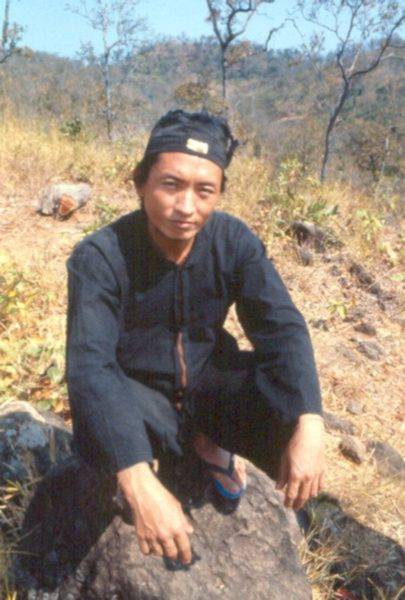 |
||
|
Thao Bee Chou in Ban Vinai
|
||
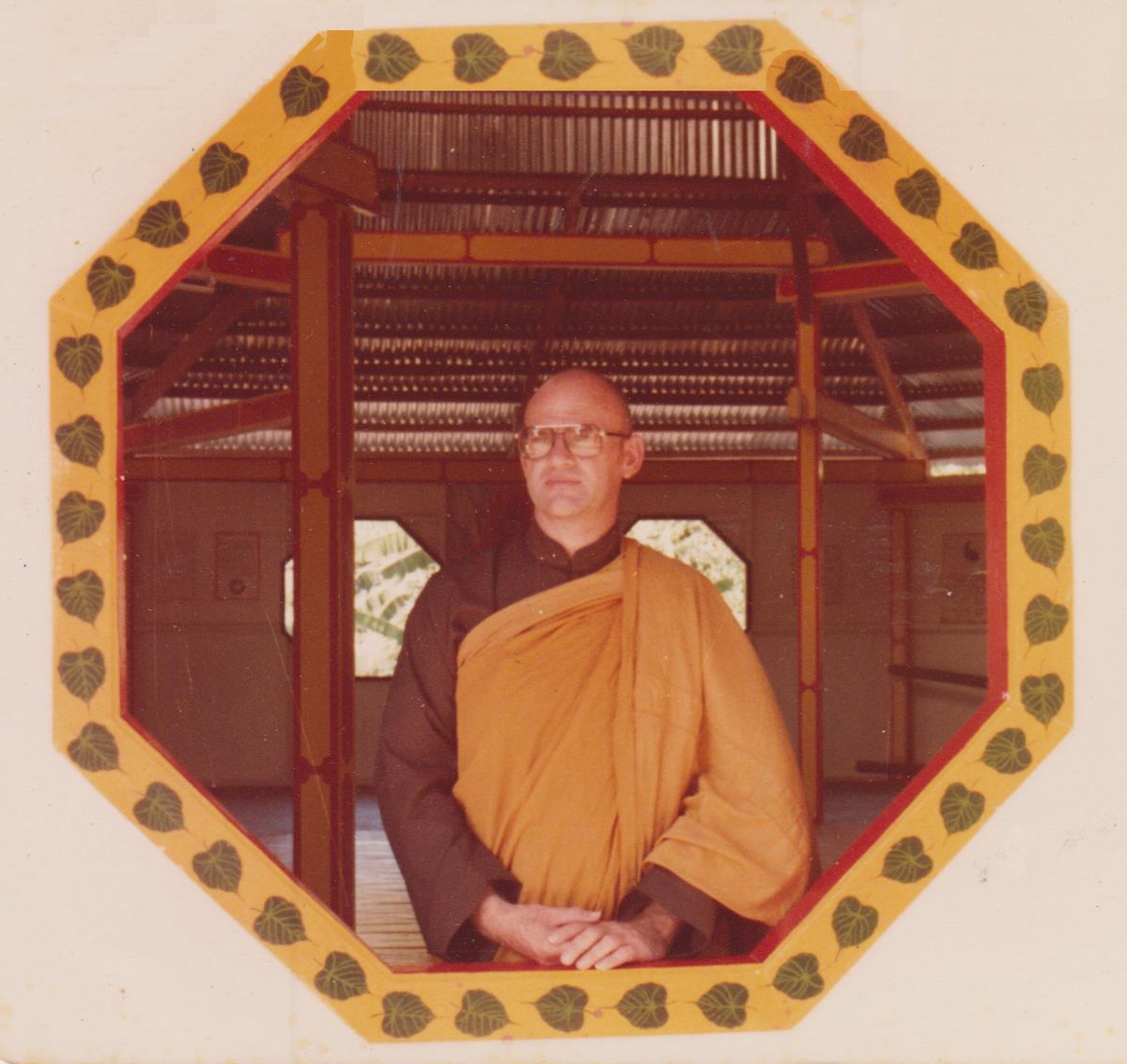 |
|||
|
Ven. Abhinyanna in the PRPC
|
|||
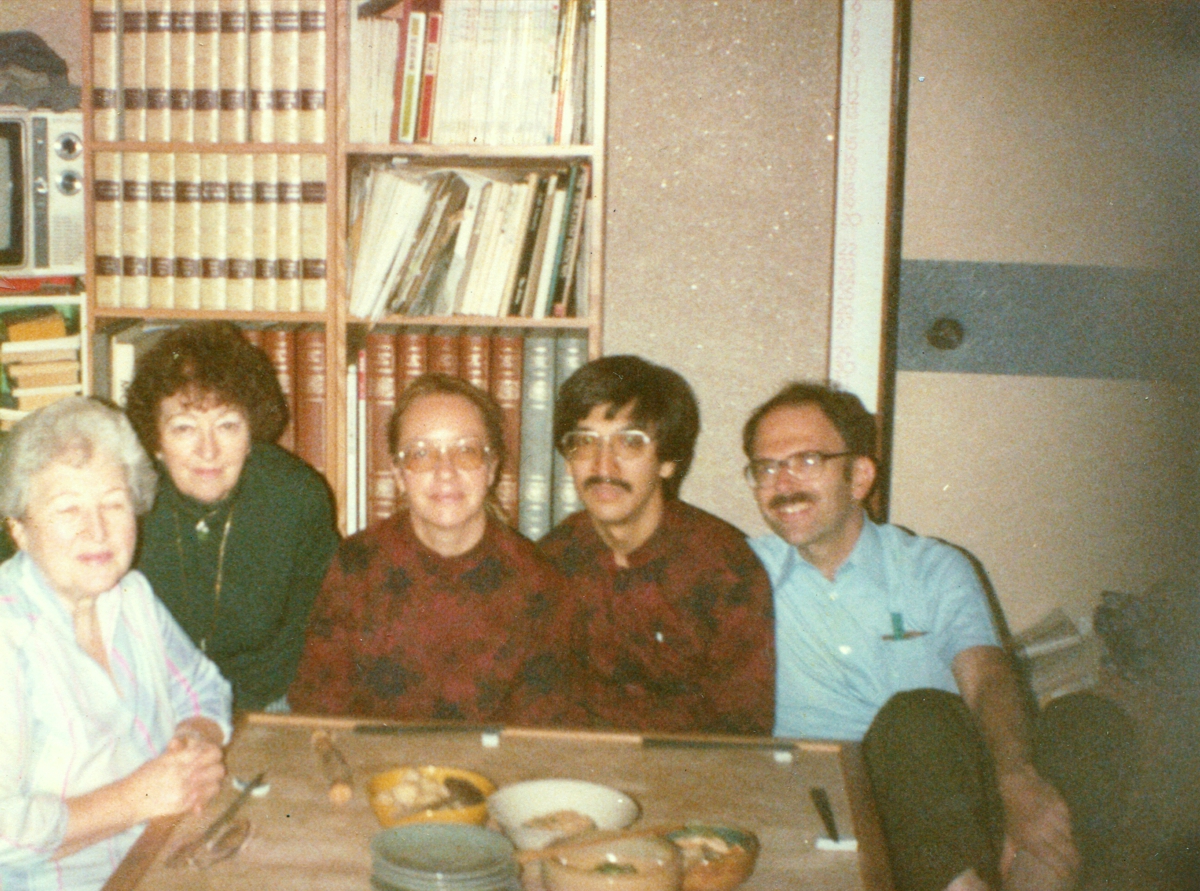 |
||
| Jack Yohay in Japan with us, his mother, and his sister | ||
 |
||
| Click the photo to see more photos of the Global Citizenship seminair. | ||
Of course, we have never forgotten that we are Americans, and that all politics is local! We just mailed in our ballots for the November mid-term elections. We have always kept ourselves well-informed of the issues; we are passionate about water, education, and the right to organize, and we have never failed to vote. We closely followed confirmation to the Supreme Court--the Senate Judiciary Committee hearings, Dr. Christine Blasey Ford's compelling testimony, Kavanaugh's shameful tantrums, and the myriad speeches by the "President" and other Republicans. It is difficult to exaggerate our distress over the current situation in the United States. Appalling, outrageous, despicable--all seem too weak! We are "governed" by spoiled infants who have no morality, no respect for democracy, and no concern for the future of the country or the world. This midterm election may be the last chance to undo the fascist coup d'etat we have just witnessed.
Everyone with a modicum of honesty is asking, "Is there no bottom?" Every day, the lies, the obscenities, the vitriol, and the scandal hit a new low. As one commentator put it, "Just when we think we have reached the bottom, they dig a basement!" We're long past the question, "Have you no sense of decency, sir?" It isn't complicated. It is really simple.. The least that is required to be a human being is morality--basic humanity.
Every religion espouses some formulation of the Golden Rule:
|
Do onto others, what you would have others do onto you.
|
|||
and the Silver Rule:
|
Don't do onto others, what you would not have others do onto you.
|
|||
In Buddhism, basic morality is defined in the five precepts:
|
not to kill,
not to steal, not to engage in sexus misconduct, not to tell lies, and not to use substances which cloud the mind. |
|
These can be expressed positively as:
|
to be kind, gentle, and caring,
to be generous, to protect the vulnerable, to be honest, and to think as clearly as possible. |
|
|
Avoid evil, do good, and purify your mind; this is the teaching of all the Buddhas.
|
||
It is also the advice of every great teacher for the successful functioning of a happy society.
How does one become pure? The Buddha gave this lesson to Cunda.
|
Purity by body is threefold. Purity by speech is fourfold. Purity by mind is threefold. How is purity by body threefold? (1) Having abandoned the destruction of life, one abstains from the destruction of life. With the rod and weapon laid aside, conscientious and kindly, one dwells compassionate toward all living beings. (2) Having abandoned the taking of what is not given, one abstains from taking what is not given. One does not steal the wealth and property of others in the village or in the forest. (3) Having abandoned sexual misconduct, one abstains from sexual misconduct. One does not have sexual relations with those who are protected by their mother, father, mother and father, brother, sister, or relatives; who are protected by their Dhamma; who have a spouse; whose violation entails a penalty; or even with one already engaged. How is purity by speech fourfold? (4) Having abandoned false speech, one abstains from false speech. If one is summoned to a council, to an assembly, to one's relatives' presence, to one's guild, or to the court, and questioned as a witness thus: "Tell what you know," then, not knowing, one says, "I do not know," or, knowing, one says, "I know"; not seeing, one says, "I do not see," or, seeing, one says, "I see." Thus one does not consciously speak falsehood for one's own ends, or for another's ends, or for some trifling worldly end. (5) Having abandoned divisive speech, one abstains from divisive speech. Having heard something here, one does not repeat it elsewhere in order to divide those people from these; or having heard something elsewhere, one does not repeat it to these people in order to divide them from those. Thus one reunites those who are divided, promotes unity, enjoys concord, rejoices in concord, delights in concord, and speaks words that promote concord. (6) Having abandoned harsh speech, one abstains from harsh speech. One speaks such words as are gentle, pleasing to the ear, and lovable, as go to the heart, are courteous, desired by many, and agreeable to many. (7) Having abandoned idle chatter, one abstains from idle chatter. One speaks at a proper time, speaks truth, speaks what is beneficial, speaks on the Dhamma and the discipline; at a proper time one speaks such words as are worth recording, reasonable, succinct, and beneficial. How is purity by mind threefold? (8) One is without longing. One does not long for the wealth and property of others thus: "Oh, may what belongs to another be mine!" (9) One is of good will and one's intentions are free of hate thus: "May these beings live happily, free from enmity, affliction, and anxiety!" (10) One holds right view and has a correct perspective thus: "There is what is given, sacrificed, and offered; there is fruit and result of good and bad actions; there is this world and the other world; there is mother and father; there are beings spontaneously reborn; there are in the world ascetics and brahmins of right conduct and right practice who, having realized this world and the other world for themselves by direct knowledge, make them known to others." These are the ten courses of wholesome kamma. These ten courses of wholesome kamma are themselves pure and purifying. It is because people engage in these ten courses of wholesome kamma that some are reborn as devas and human beings and in other good destinations. --Anguttara Nikaya 10, 176 |
|||
In our last report, we asked what might cause the end of civilization. As we were wondering from what direction that total disaster will come and what sort of calamity it will be, we considered previous disasters throughout the world and the reaction to them. This led to the development of a new activity for our classes. First, we reviewed many historical disasters, both natural and manmade. Of course, we could not include them all, so we had to choose those which seemed most interesting, even though they were not the most important or the most destructive. We tried to choose those which represented a wide range in geography, politics, intensity, and cause. Once we had chosen twenty-two disasters, we searched the web for facts and photos. The research was fascinating, and we ourselves learned a great deal.
For each disaster, we created a poster of six to eight photos, which we mounted on the walls. After reading brief descriptions of the events, students tried to match the description with its respective poster. The photos were graphic (crucifixions in the Armenian genocide), and, in some cases, macabre (piles of bodies in the Holocaust and the Cambodian genocide). Some especially powerful (Africans tightly packed in the ship's hold in the Atlantic Slave Trade). Others particularly gruesome (rubber workers whose hands had been amputated in the Congo Free State). The students were eager to express their emotions after having seen all the photos.
The next step was to read together more detailed descriptions of the disasters. In each one, the dates and all numbers had been removed. Thus, the activity became an exercise in hearing numbers, as well as learning about the disasters themselves. The students were amazed at the realization that the death toll from the Boxing Day Tsunami and the 2010 Haiti Earthquake were almost the same, but that the former included many countries around the Indian Ocean, whereas the latter took place on half of a small island. They were also fascinated to learn about the religious, social, and scientific influence the Lisbon Earthquake of 1755 had on Europe. Voltaire referred to it in Candide, and Rousseau used it to prove his theory that man should abandon cities and return to nature. Most surprising, though, was that, because 85% of the buildings in the city collapsed, architects, for the first time, began designing earthquake-proof structures. To test the strength of the buildings, they marched soldiers through the streets to simulate an earthquake. It was the beginning of seismic architecture.
The final step in the activity is to place the disasters on a timeline of history, from the Black Death in the fourteenth century to the Tohoku Earthquake in 2011 and to locate them on a world map.
Anyone who has been reading our reports knows that, for at least four years, we have decried "global warming," "environmental disruption," and "climate catastrophe." We first used An Inconveniert Truth in our lessons in 2008. For more than two years, we have referred to and suggested that friends watch the video "Human Extinction by 2030 -- There's No Tomorrow." Thus, it came as no surprise to read about the new UN report in the local Daily Mirror, with a blaring headline
The world has until 2030
|
|||
Nevertheless, the report is important, and, unfortunately, as an article on Hullabaloo explains, is overshadowed by seemingly "more pressing" issues. It shouldn't be. Actually, here is another article which claims that the UN report is watered down and that a date of 2030 is optimistic
Our last report included the saga of the application for extension of permission to stay in Sri Lanka. We are happy to report that the saga ended successfully. Sincere thanks to the Ministry of the Sasana.
Two days before we went to Colombo, we had a big party. A few months ago, Candace, a friend in Flint, informed us that one of her friends, Michael, a professor at Yale, was coming to Sri Lanka for his son's wedding. Happily, he and his family followed our suggestion and availed themselves of Jagath's services. He perfectly arranged and managed their full tour of the island. When the group reached Kandy, we hosted the entire family, a party of eight, for lunch, along with Jagath's family and other friends we wanted them to meet. Michael had brought a suitcase chockfull of items we'd ordered and had shipped to him for us and for Julia. When the suitcase was empty, we gave him a like number of packages of Sri Lankan coffee, teas and spices to take back to the States and mail to some of our friends. From Candace, he carried a beautiful handcarved cat from Indonesia, which continues meditating in our entry. We hope that some of the party will return for a longer stay in Kandy, which to our way of thinking is becoming the center of the world!
 |
|||
| Click the photo to see more photos of that day. | |||
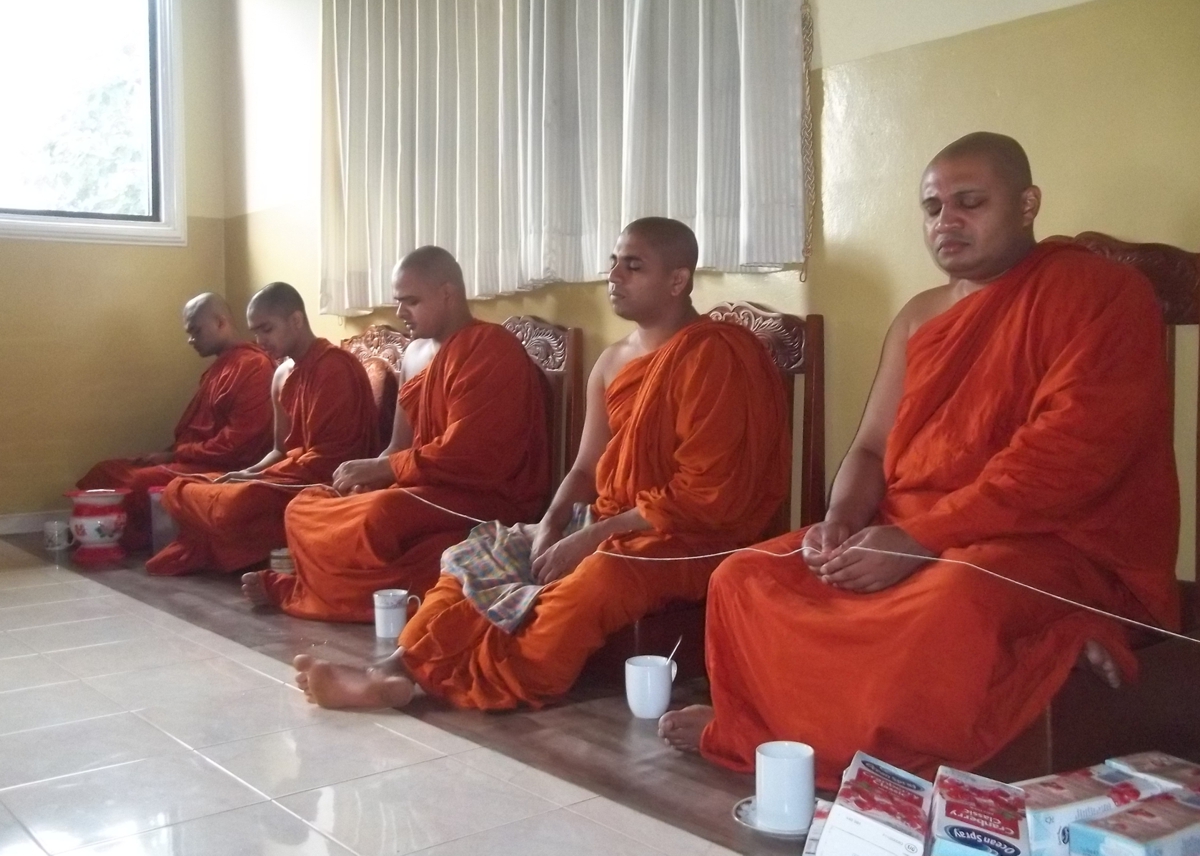 |
||
| Click tyhe photo to see more photos of the dana at Vajirarama. | ||
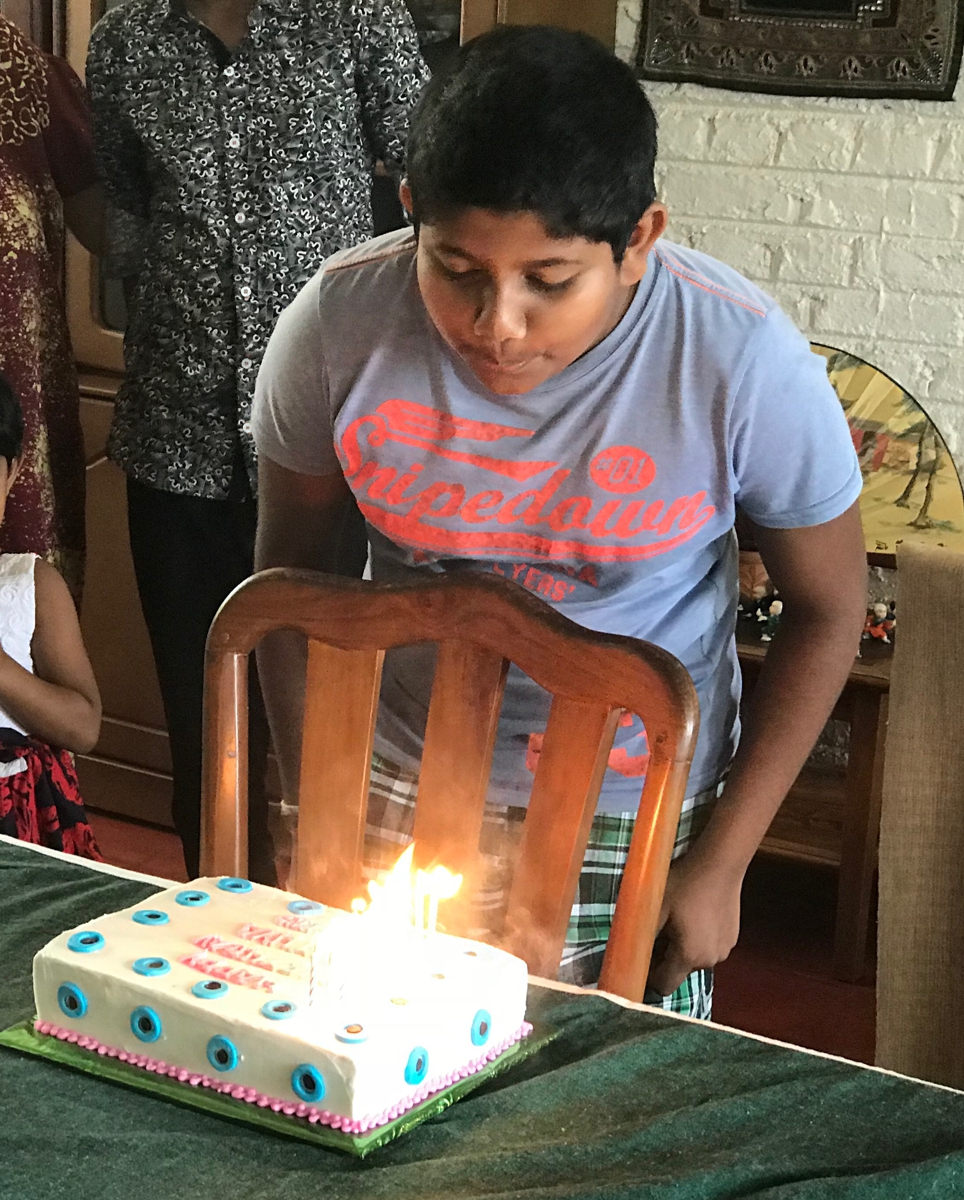 |
||
| Click the photo to see more photos of Shehan's birthday party | ||
 |
||
| Click the photo to see more photos of the three birthdays. | ||
Ven. Amilasiri seemed healthier than we had seen him in a long time. Unfortunately, the Kurunegala area is still suffering from drought. Much of Sri Lanka is in that situation, although other parts have too much rain. Although there had been a brief period of rain, the wells are still low and water needs to be carefully conserved. We stopped on the way to the monastery and purchased 12 19-liter bottles of drinking water, which was very gratefully received.
Most of the novices were at the pirivena where they study, since the next day was full moon and they were to be there for a big dana offering.
Some of the elderly monks came up for their lunch, but there were five in the ward who needed to be served separately. We didn't ask about individual monks, but we did learn that a funeral now costs about sixty thousand rupees (up from thirty-five thousand last year).
Because we'd expected the novices to be there, there was a lot of food left over, which was good, because Ven. Amilasiri informed us that the villagers are not able to offer dana everyday. The drought is, of course, severely affecting the farmers there and in the north.
 Mike took a photo of the fallen stone marker overlooking the excavation where the previous administration had promised to build a five-story sangha hospital. Ven. Amilasiri never mentions that fiasco. Let patient perseverance replace repeated disappointment. We were pleased to see that he had hung, in the entry of the ward, all the framed paintings of the life of the Buddha we had offered on our last visit.
Mike took a photo of the fallen stone marker overlooking the excavation where the previous administration had promised to build a five-story sangha hospital. Ven. Amilasiri never mentions that fiasco. Let patient perseverance replace repeated disappointment. We were pleased to see that he had hung, in the entry of the ward, all the framed paintings of the life of the Buddha we had offered on our last visit.
 |
||
| Click the image to see more about the SCC event | ||
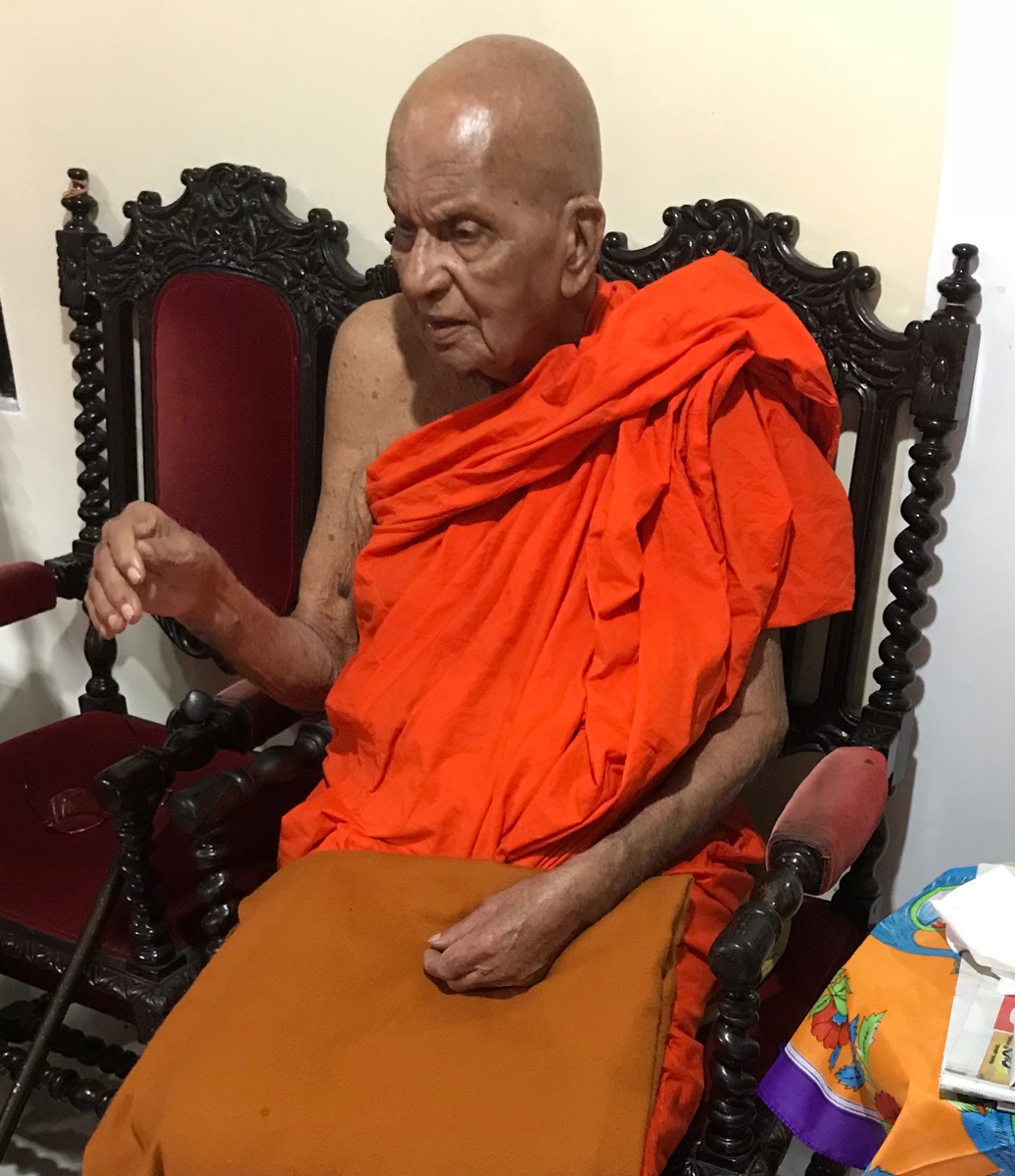 |
|
| Click the photo to read the local newspaper account. | |
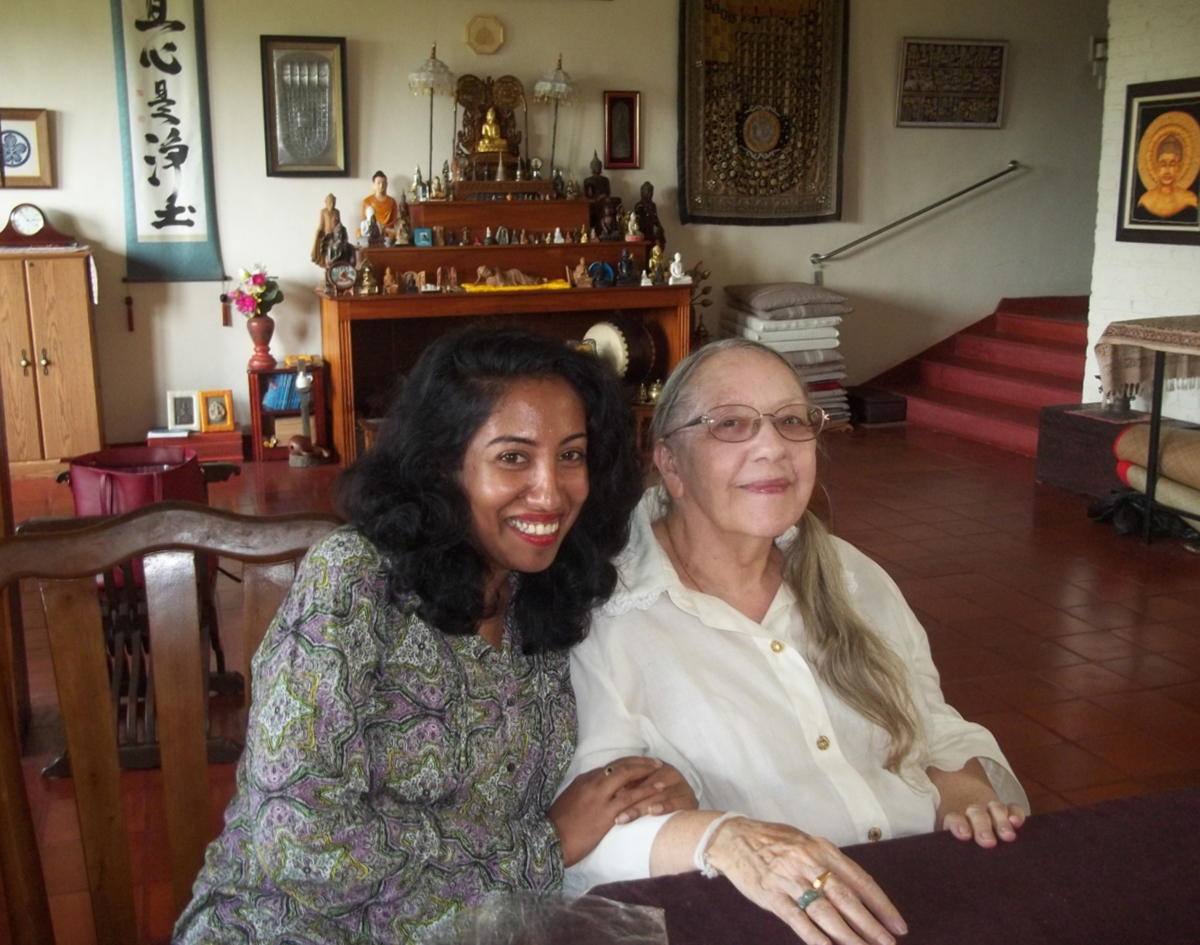 For the past few years, we have been involved with various activities at the American Corner Kandy. For most of that time, Menusha was the coordinator. We very much enjoyed working with her. Recently, she resigned and received a full scholarship to study social development at Sussex University in the UK. We wrote to old friends Carolyn, Takashi, and their daughter Hannah, suggesting that they meet Menusha, perhaps helping her get settled in England. Carolyn immediately replied:
For the past few years, we have been involved with various activities at the American Corner Kandy. For most of that time, Menusha was the coordinator. We very much enjoyed working with her. Recently, she resigned and received a full scholarship to study social development at Sussex University in the UK. We wrote to old friends Carolyn, Takashi, and their daughter Hannah, suggesting that they meet Menusha, perhaps helping her get settled in England. Carolyn immediately replied:
|
Of all the universities in the UK, its strange Menusha will be in the same one as Hannah, and the same department--global studies! No doubt we will see her when we next go down to visit. Its good to hear that our government is still doing something decent, in terms of scholarships. Nothing much else is going on to give any sense of good feeling. |
|||
Hannah and Menusha have already met, and they have hit it off splendidly. Happy!
Mike's biggest birthday present this year was the surprise visit from his mother. We, too, were happy to meet Barbara again after so many years. On October 5, we scheduled a high tea for a few friends--no Coopoly this time, just good food and good conversation. Lovely!
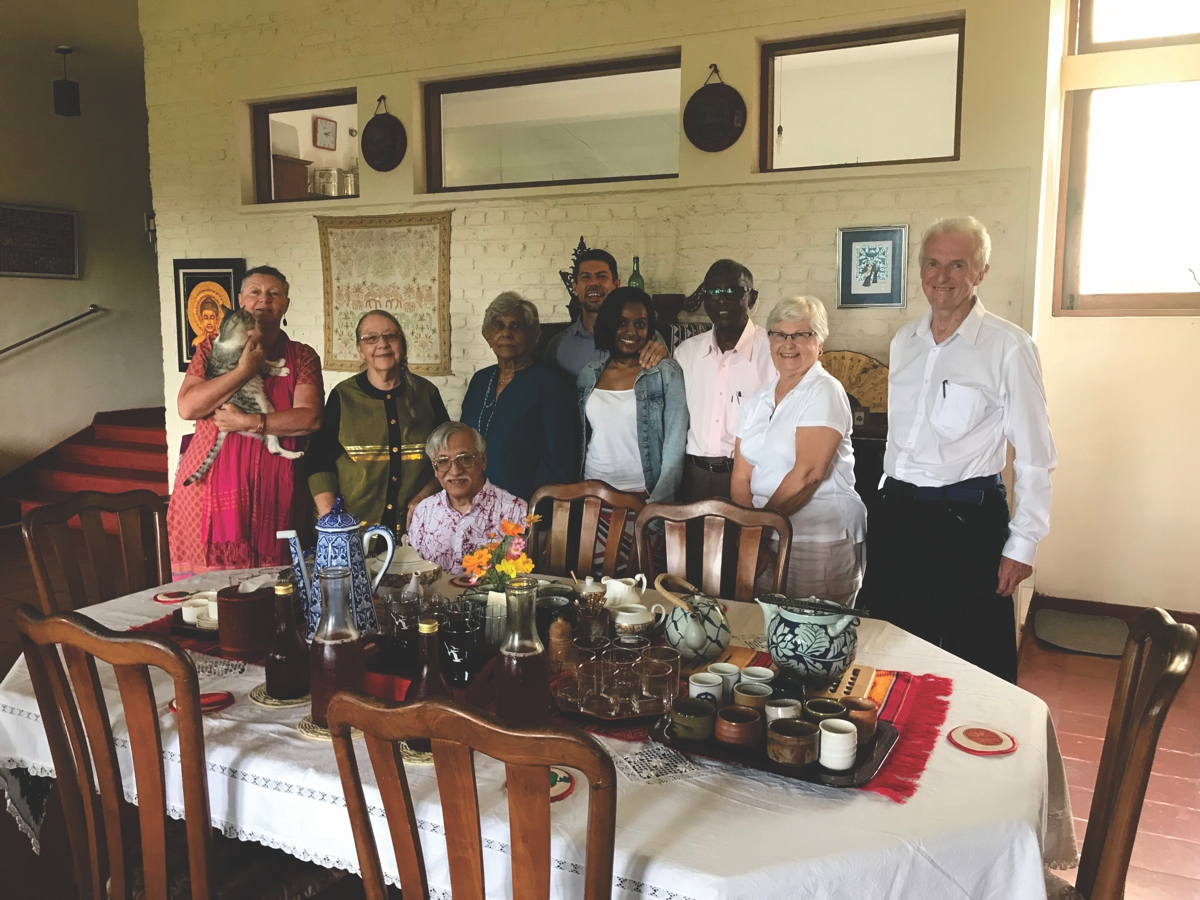 |
 |
||
| (l to r) Julia (with Nezumi), Visakha, Ken, Lalita, Mike, Rushma, Jaya, Barbara, and Ewen. (Click to enlarge) | |||
| As quickly as possible, we will be uploading all of our ESL and critical thinking activities and lessons online for free download. We hope to announce the URL for that website in our next report. We hope that this material will be useful to many teachers. | |||